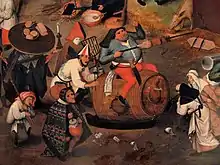Culture of popular laughter
The "culture of popular laughter is a cultural-historical term coined by the literary critic Mikhail Bakhtin in his book Rabelais and His World (1965). This studied popular culture in Renaissance Europe through the themes of François Rabelais' book Gargantua and Pantagruel (1532–64). The idea of the culture of popular laughter combines two literary ideas developed by Bakhtin in the same work: "grotesque realism" and "carnivalesque" which examined, respectively, the celebration of primary needs and the idea of carnival in which social norms were subverted.

The culture of popular laughter was originally formulated based on the writings of Rabelais, but has also been applied in the interpretation of peasant scenes painted by Pieter Bruegel the Elder and his descendants.[1] The example has also been applied to Japanese society.[2]
Carnivalesque
The idea of "carnivalesque" coined by Bakhtin also forms part of his wider theory of popular laughter. He argued that, during times of carnival such as the Feast of Fools, social norms were deliberately inverted. The carnival then became a form of "safety-valve" institution, which served a structural-functionalist role to temporarily release stresses in the contemporary social system.[3] Bakhtin, however, argued that this form of system was "formalized" in the culture of the period as "popular laughter".
Relevance
The historian Gábor Klaniczay argued that "popular laughter" stretched through all echelons of society and was not restricted to the peasantry.[4] Bakhtin's theory has also been credited with bringing about a scholarly reassessment of the importance of popular culture in history.[5]
References
- Gibson, Walter S. (2006). Pieter Bruegel and the Art of Laughter (1st ed.). Berkeley: University of California Press. p. 33. ISBN 0520245210.
- de Wil, Theodore; et al. (2001). Sources of Japanese tradition from earliest times-1600. 1 (2nd ed.). New York: Columbia University Press. p. 471. ISBN 0231121393.
- Klaniczay, Gábor (1990). The Uses of Supernatural Power: the Transformation of Popular Religion in Medieval and Early-modern Europe. Princeton, N.J.: Princeton University Press. p. 12. ISBN 0691073775.
- Klaniczay, Gábor (1990). The Uses of Supernatural Power: the Transformation of Popular Religion in Medieval and Early-modern Europe. Princeton, N.J.: Princeton University Press. p. 17. ISBN 0691073775.
- Klaniczay, Gábor (1990). The Uses of Supernatural Power: the Transformation of Popular Religion in Medieval and Early-modern Europe. Princeton, N.J.: Princeton University Press. p. 24. ISBN 0691073775.